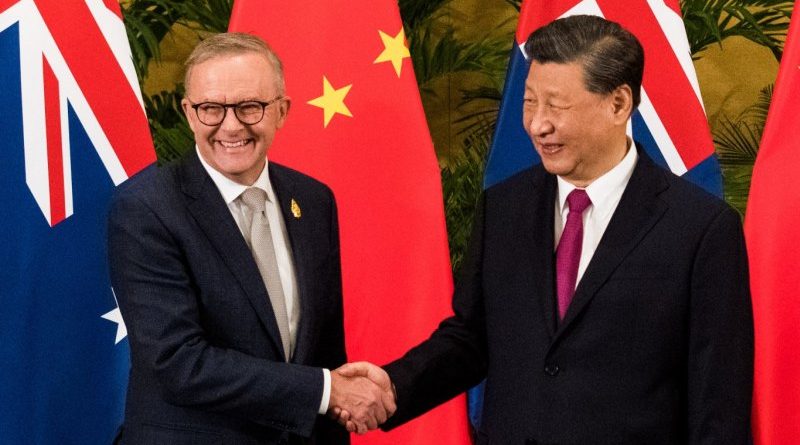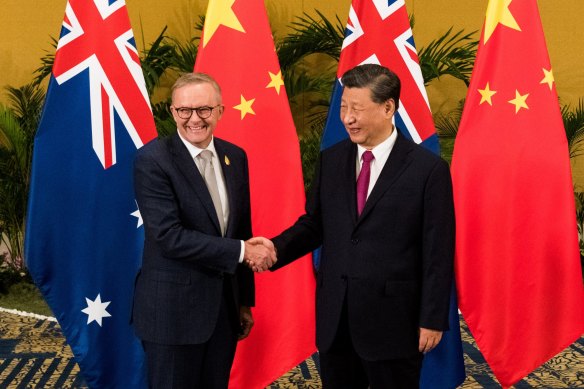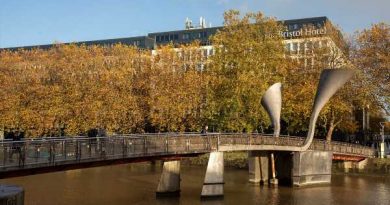After ending the freeze with Australia, China fancies joining trade bloc
Save articles for later
Add articles to your saved list and come back to them any time.
First, there was coal, then there was barley. On Sunday, wine became the latest Australian export to be given a reprieve by Beijing. Now only lobsters remain on the tarmac.
After three years, all but one of half-a-dozen exports caught up in $20 billion in trade strikes by the Chinese government have been given an official reprieve.
Prime Minister Anthony Albanese confirms he will visit China from November 4 to 7 where he will meet President Xi Jinping.Credit: James Brickwood
The olive branch has been extended. The thaw is under way. Any number of clichés now threaten to surround Prime Minister Anthony Albanese’s visit to Beijing in November.
Since China lifted restrictions on Australian coal imports in March, negotiations have moved rapidly. Not only are most trade sanctions in the process of being lifted, but Australian journalist Cheng Lei has been released from jail. The relationship can never be fully stabilised until one more Australian, Yang Hengjun, is freed from his Beijing cell.
But it is difficult to reconcile with the years of frozen ministerial contact and daily barbs from the Chinese Foreign Ministry without getting whiplash. China, as only a one-party state can do, has turned on a dime.
What did China want? Well, we know because it released a list in 2020: Beijing’s 14 grievances, first reported by this masthead and Nine News.
Top of its list was foreign investment decisions blocked by the Australian government.
On Friday, the federal government said it would not cancel Chinese company Landbridge’s 99-year lease of the Port of Darwin.
The Albanese government said it did not operate on a transactional basis with China. This, of course, is nonsense. China needed a symbolic win out of its negotiations, and on Friday it got it.
Three of the items on the list are more about public rhetoric than actual policies.
They include the “politicisation and stigmatisation” of normal exchanges and co-operation between China and Australia, “siding with the US’ anti-China campaign”; the “incessant wanton interference” in China’s Xinjiang, Hong Kong and Taiwan affairs, and spearheading “the crusade against China in certain multilateral forums”.
In the heat of the diplomatic battle over human rights, national security and COVID-19, the former Coalition government was in a daily sparring match with Beijing. At one point, then-prime minister Scott Morrison called a snap press conference from his COVID lockdown in The Lodge to respond to a tweet by a lowly Chinese Foreign Affairs official.
Tempers were high, tensions flared, and cooler heads in Canberra did not prevail.
Since it came to office, Labor has largely addressed these three grievances through a change in tone.
Albanese and Foreign Minister Penny Wong have made their concerns about Xinjiang and Hong Kong known, but mostly in private. Often they will discuss them only after meeting their Chinese counterpart first, and rarely in set speeches.
COVID-19 has subsided, eliminating what was once a major flashpoint, and the change in government in Australia created a natural break for a rhetorical reset. It culminated in Wong’s Australian formula of “co-operate where we can, disagree where we must, and engage in our national interest”, which has guided almost all Australian policymaking on China since.
In Singapore in June, in a speech to the Shangri-La Dialogue, one of the few places in the world where Chinese and Western leaders mingle freely, Albanese laid out his China policy. It recast Australia as a middleman in the region, rather than a vanguard of US influence. It did not go unnoticed by the Chinese officials in the room.
Importantly, little ground has been ceded on the policies that sparked the list of grievances that were hard won by the Coalition on national security grounds. Huawei is still banned from the 5G network, it is unlikely any state will attempt to enter into another Belt and Road agreement, and the foreign interference legislation is now being replicated around the world.
All the while, Australian trade with China has soared to record highs of almost $300 billion, driven mostly by iron ore. Most of the products sanctioned by China found other markets, offsetting almost all of their losses, according to research by the Lowy Institute’s Roland Rajah.
The trade sanctions had little real economic impact at all, except for winemakers who, after Sunday’s announcement, can look forward to filling Beijing bottle shops with litres of full-bodied Shiraz before long.
The lobsters are not far off either, and, let’s be honest, many of them have been sneaking into China for the past two years through Hong Kong, where imports suddenly grew by 2000 per cent in one quarter of 2021.
Throughout it all, China has made one request clear. It wants to join the Comprehensive and Progressive Agreement for Trans-Pacific Partnership — a giant trade bloc between a dozen countries that requires each of them to agree to a new member joining.
In October last year, Trade Minister Don Farrell said he did not “believe there is any prospect that China could join”. By May, that had softened slightly to “they’re not currently complying with their existing obligations”. In July, Assistant Trade Minister Tim Ayres said: “I think consideration of future accession applications is some way off.”
But the door is now slightly ajar.
China in the trans-Pacific partnership? Stranger things have happened.
Most Viewed in World
From our partners
Source: Read Full Article




